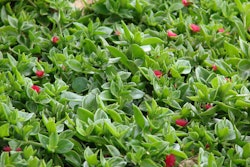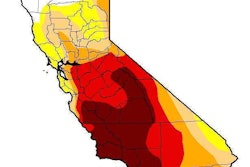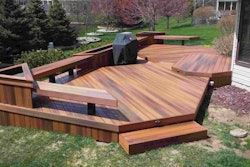
It is important to keep the pond clean of falling debris and decaying leaves, as these can sometimes injure the fish and their decomposition adds to the ammonia load and makes the water too acidic.
As the temperatures cool, advise your clients to feed their fish wheat germ-based food as it is highly digestible at low temperatures. The fishes’ metabolism is greatly diminished in colder months. Customers should not feed their fish at all when water temperatures drop below 39 degrees Fahrenheit.
For fish to be able to survive the winter outdoors, the pond depth needs to be at least 18 inches, but in some extremely frigid areas of the country a pond 30 inches or deeper is needed.
“Water is a unique substance,” says Jeff Rugg, a University of Illinois Extension horticulture educator. “At about 40 degrees Fahrenheit, it is denser than water warmer or colder, so the 40-degree water settles to the bottom of the pond. It forms a puddle that, if left undisturbed, will not mix with the colder water above it. The ice floating on the top of the pond insulates the water from even colder air above it. Koi and goldfish can safely spend the winter hibernating in the 40-degree water.”
Depending on your location, winter weather may be moderate enough to allow the pumps to keep running, keeping the pond surface from freezing. In colder climates, clients should shut down their pumps so the warmer water at the bottom of the pond where the fish hibernate does not mix with the colder waters near the surface.
UV clarifiers should be stored indoors, and filters can be as well if the manufacturer’s directions suggest to do so. If pumps are stored outside or in an unheated space, make sure there is no water left in the device to freeze. Pumps kept indoors should be kept in a bucket of water to keep the seals and moving parts wet.
During the winter it is crucial to keep an area of the pond free of ice to allow toxic gases like carbon dioxide, methane and hydrogen sulfide to escape. A one-foot diameter opening per 100 square feet of pond surface area will suffice.
Pond de-icers are used to keep this area from freezing over as breaking ice on a pond can be harmful and even fatal to the fish.
According to Rugg, low wattage de-icers are not more energy efficient than high wattage deicers.
“All heating devices work the same, because physics is involved,” he says. “It takes a specific number of calories of heat energy to raise the temperature of an object a specific number of degrees. A single candle over a period of time will generate the same number of calories as a blow torch over less time.”
He suggests insulating de-icers. Doing so will trap the lost heat and help it work more efficiently. If your client notices the fish gasping at the opening in ice, this means there is a lack of oxygen or a buildup of the toxic gases.
“Find a way to enlarge the hole for better gas exchange using another bubbler or heater,” Rugg says. “Do not pound on the ice. If necessary, use a garden hose to melt a larger hole. Use a dechlorinator if the hose water has chlorine in it.”
Don’t let your customer become too caught up in their fish because there are also tender plants that need taking care of before Jack Frost comes to visit. All tropical plants obviously must be moved indoors if they want them to survive. Umbrella plants, taro, elephant ears, water cannas can all be cared for indoors by placing them in a south or west window and keeping the soil moist.
Tropical water lilies require a large aquarium and 12 to 18 hours of light a day with 75 to 80 degree temperatures. Water hyacinths are usually considered annuals and simply replaced each season.
Hardy water lilies and bog plants require a good pruning to the root crown and do not need to be moved.











